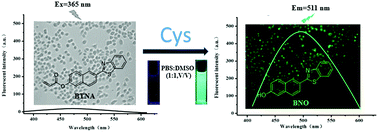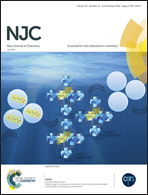A novel naphthalene-based fluorescent probe for highly selective detection of cysteine with a large Stokes shift and its application in bioimaging†
Abstract
An efficient naphthalene-based fluorescent probe (BTNA) for cysteine (Cys) has been rationally designed and synthesized in this work, which consists of a 6-(2-benzothiazolyl)-2-naphthalenol (BNO) fluorophore connected with an acrylate group (the fluorescence quenching and response group). This probe was designed based on a photo induced electron transfer (PET) process and the conjugated addition/cyclization sequence mechanism was employed for Cys detection. It is notable that this novel probe exhibits good linearity ranges with a low detection limit of 0.18 μM for Cys as well as a large stokes shift (λem − λex = 140 nm). Besides these, as a turn-on fluorescent probe, it shows high selectivity and sensitivity for Cys over other amino acids and common ions including the similar structured homocysteine (Hcy) and glutathione (GSH). Finally, the probe BTNA was successfully applied for bioimaging intracellular Cys in living Hela cells with low cytotoxicity.



 Please wait while we load your content...
Please wait while we load your content...